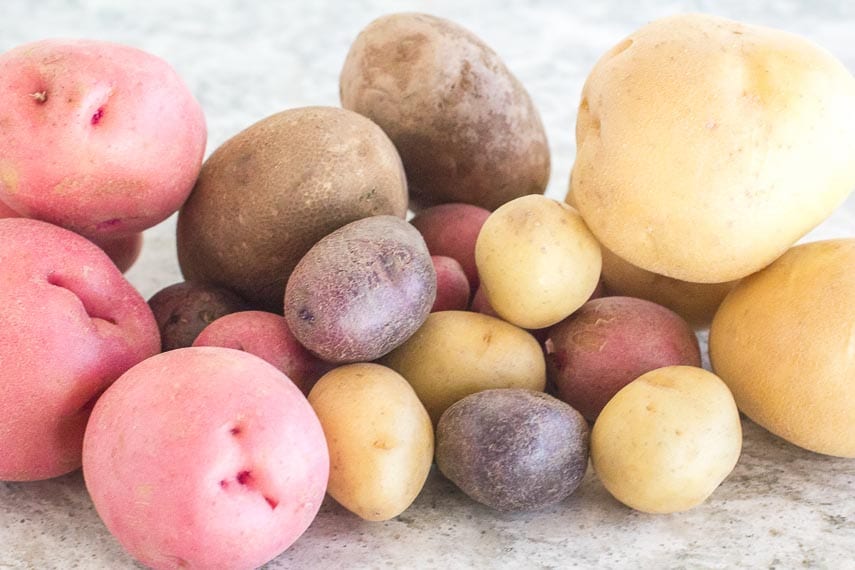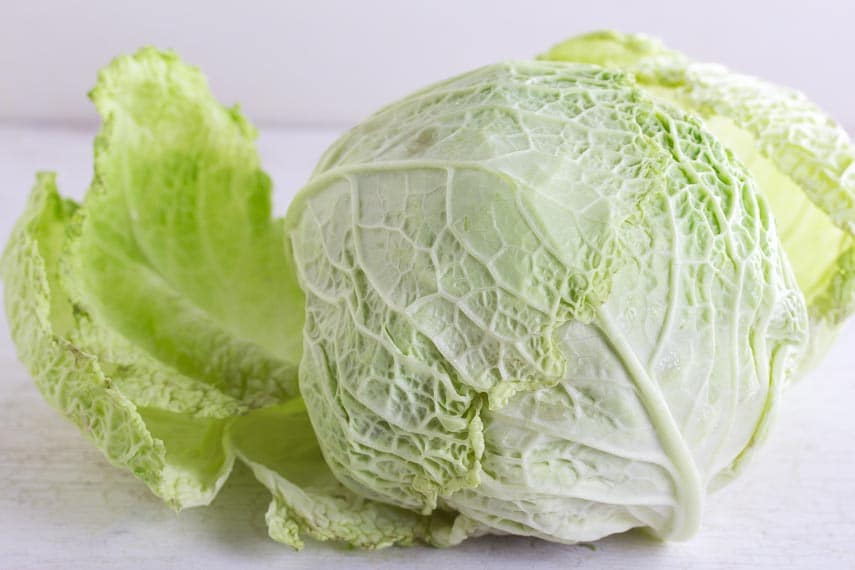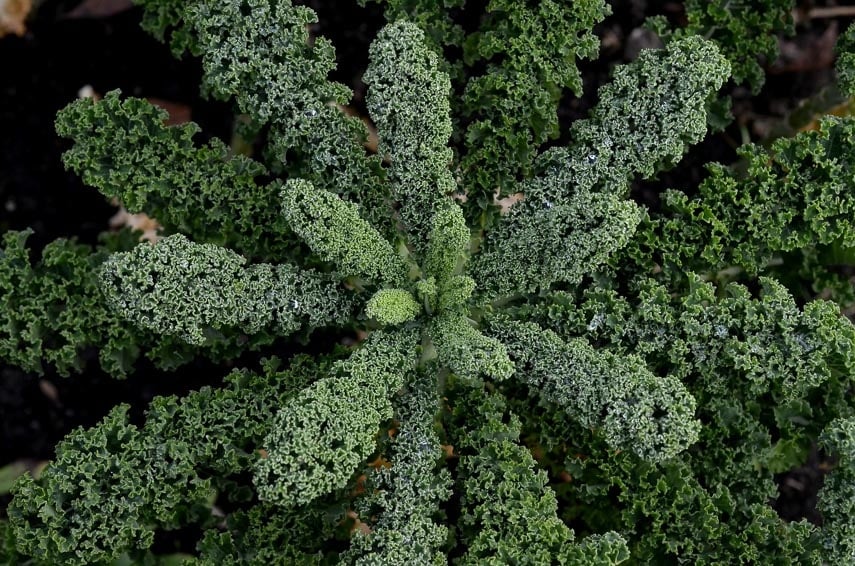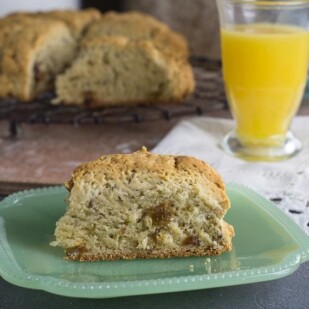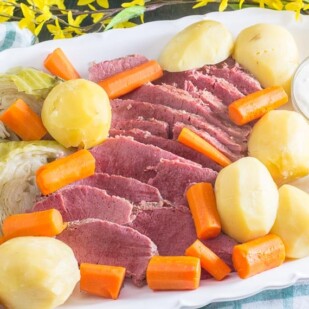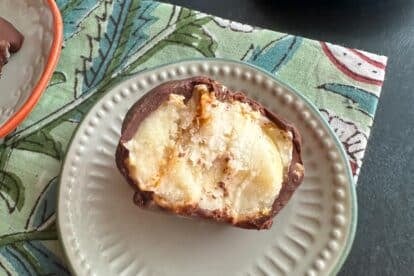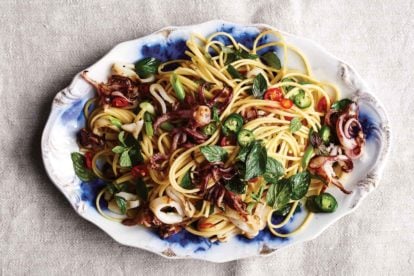Our Low FODMAP Colcannon features starchy mashed potatoes with shreds of tender cabbage and kale, lactose-free whole milk and rich Irish butter. Salt and pepper bring the flavors together in this classic Irish recipe. Colcannon is often served on St. Patrick’s Day, but it is a perfect potato side dish for any time of the year.
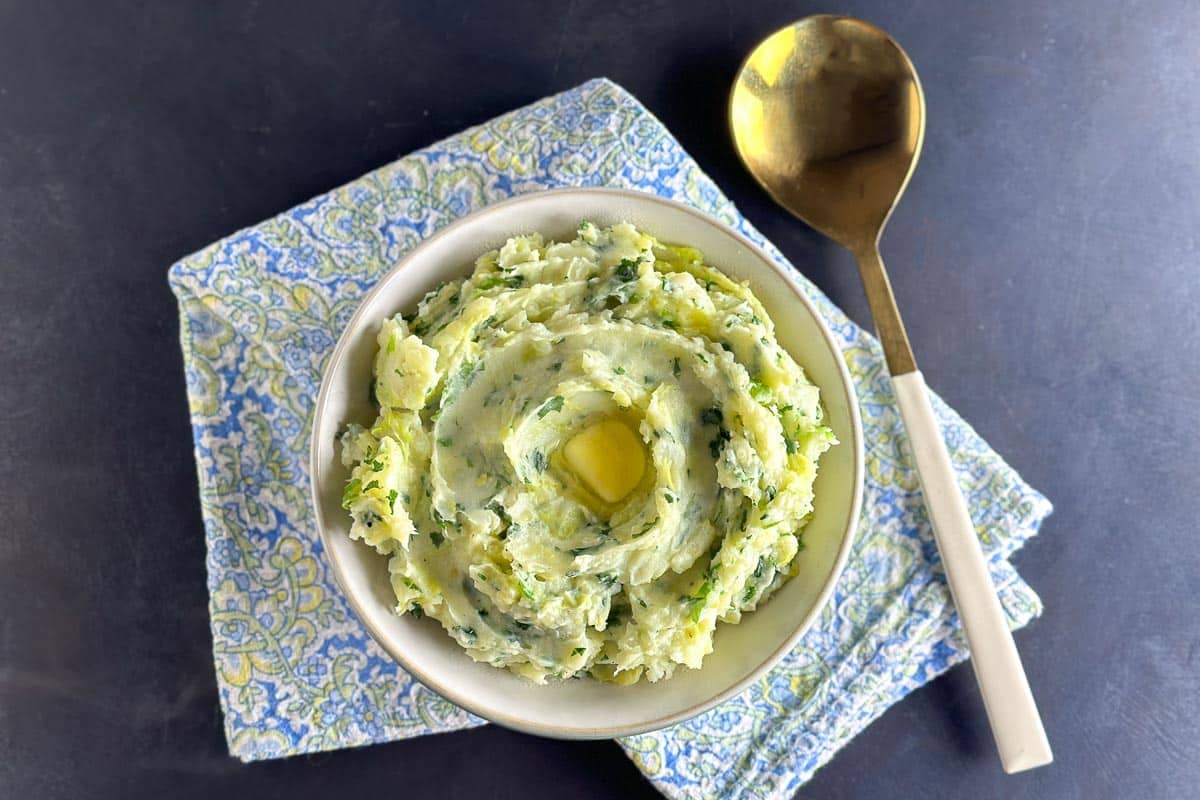
If you are a mashed potato fan and have never had colcannon, you have a treat in store.
Frequently Asked Questions
At its simplest, colcannon is a mashed potato dish, rich with butter and either milk or cream, with the addition of shredded cabbage and/or kale. Seasoning is simply salt and pepper. Sometimes you will see leeks or scallions as part of the recipe as well.
The word “colcannon” derives from the Gaelic term “cal ceannann”, which translates as “white-headed cabbage.”
Any dish that goes with a side of mashed potatoes goes well with colcannon.
Colcannon is often served on St. Patrick’s Day, but it is a perfect potato side dish for any time of the year. It is a rustic dish – not a “special” dish only to be reserved for holidays.
Yes, potatoes are low FODMAP, and we have an entire article for you in our Explore An Ingredient: Potatoes.
Yes, cabbage si low FODMAP and we have an entire article for you in our Explore An Ingredient: Cabbage. This makes an interesting read as different kinds of cabbages not only contain different amounts of cabbage, but also different FODMAPs themselves. We like using Savoy cabbage for our Colcannon.
Yes, kale is low FODMAP, and we have an entire article for you in our Explore An Ingredient: Kale. In fact, kale has just traces of FODMAPs.
Butter is a fat and does not contain carbohydrates, therefore it contains no FODMAPs. For this recipe we suggest Kerry Gold Pure Irish Butter, or another Irish butter that you can source. They are extra rich and add to the dish in flavor and texture.
Irish butter is extra rich and typically has a higher butterfat content than typical supermarket butter. It is usually at least 2% higher. You could use any high fat butter, and we do recommend it, but if you can only find regular supermarket butter, use salted, as the Irish butter we recommended comes salted.
As with so many classic comfort foods of the world, there are many regional variations. Some start with bacon; some recipes suggest boiling the greens either alone or with the potatoes; other recipes have you sauté the greens in the butter. We have seen recipes with just cabbage and also, you will note, that some recipes suggest peeling the potatoes first, while others (like ours) suggest peeling after boiling.
We chose this approach for this dish because it is ALL about the potatoes and the flavor that the skin lends is immense. Peeling them after cooking is not as hard as you might think. The skins pretty much slip off; just let the potatoes cool enough to handle. Then, to bring it all together, use a hand-held potato masher.
You can also enjoy your leftover colcannon for breakfast! Fry in more butter to make crispy potato pancakes and serve with poached or fried eggs. It is wonderful with leftover corned beef.
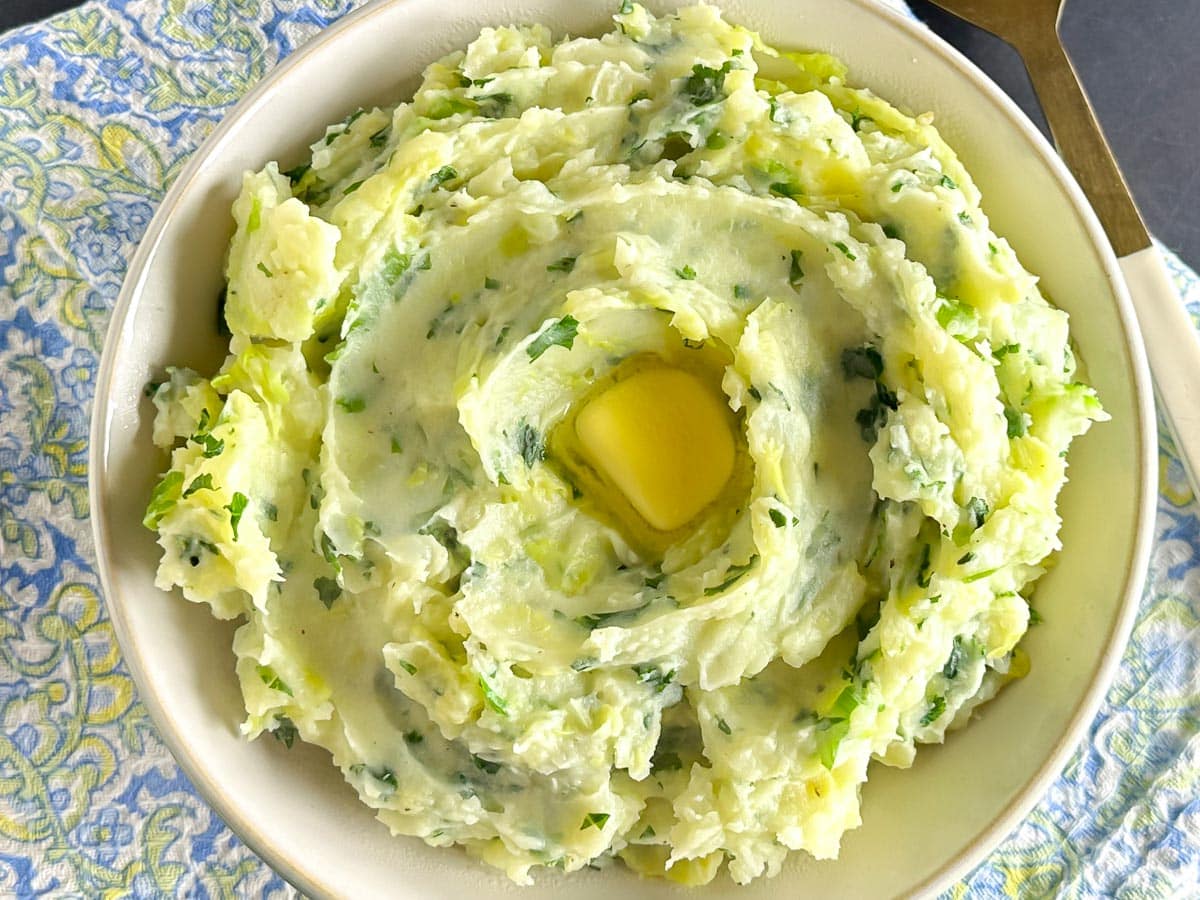
Making Colcannon
Place potatoes in a large pot.
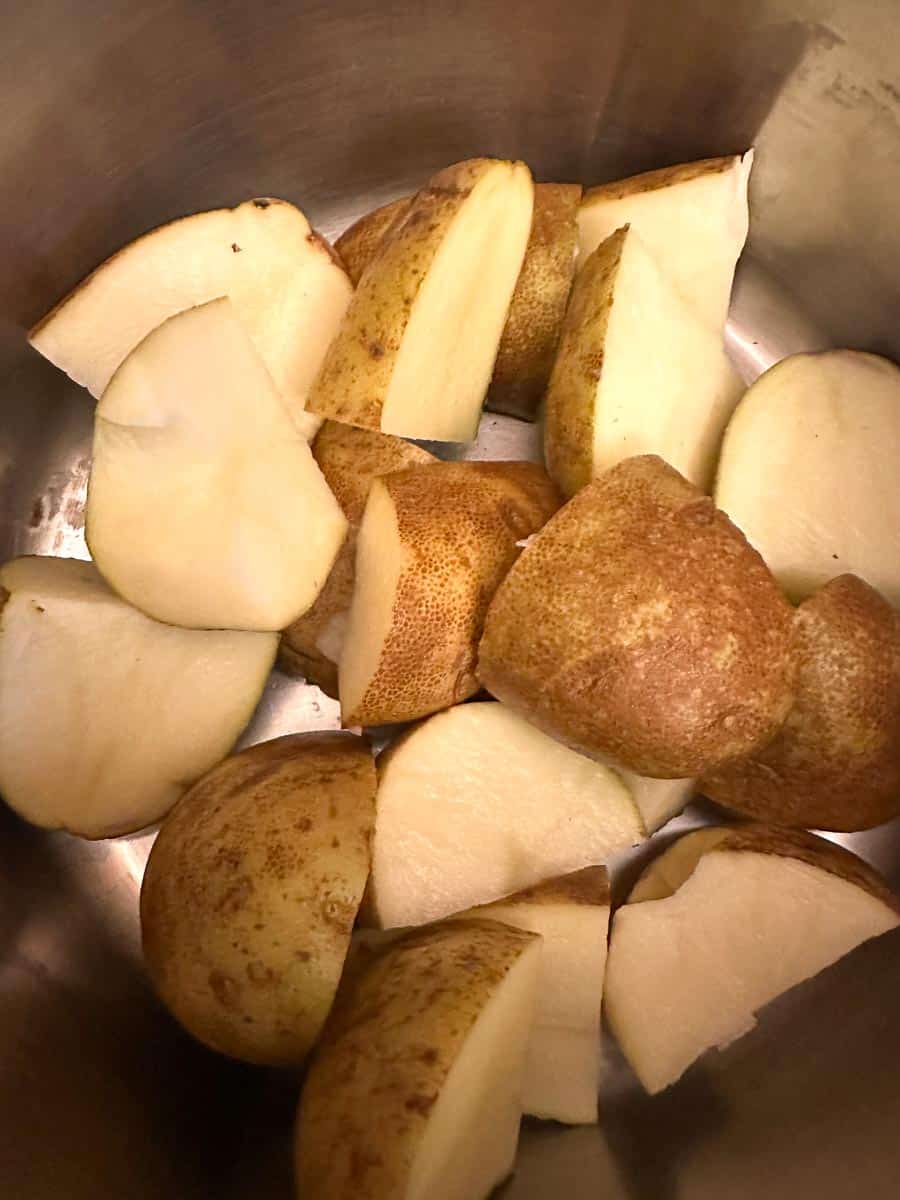
Cover with water by at least 1-inch (2.5 cm). Add a large pinch of kosher salt to the pot, cover and bring to a simmer.
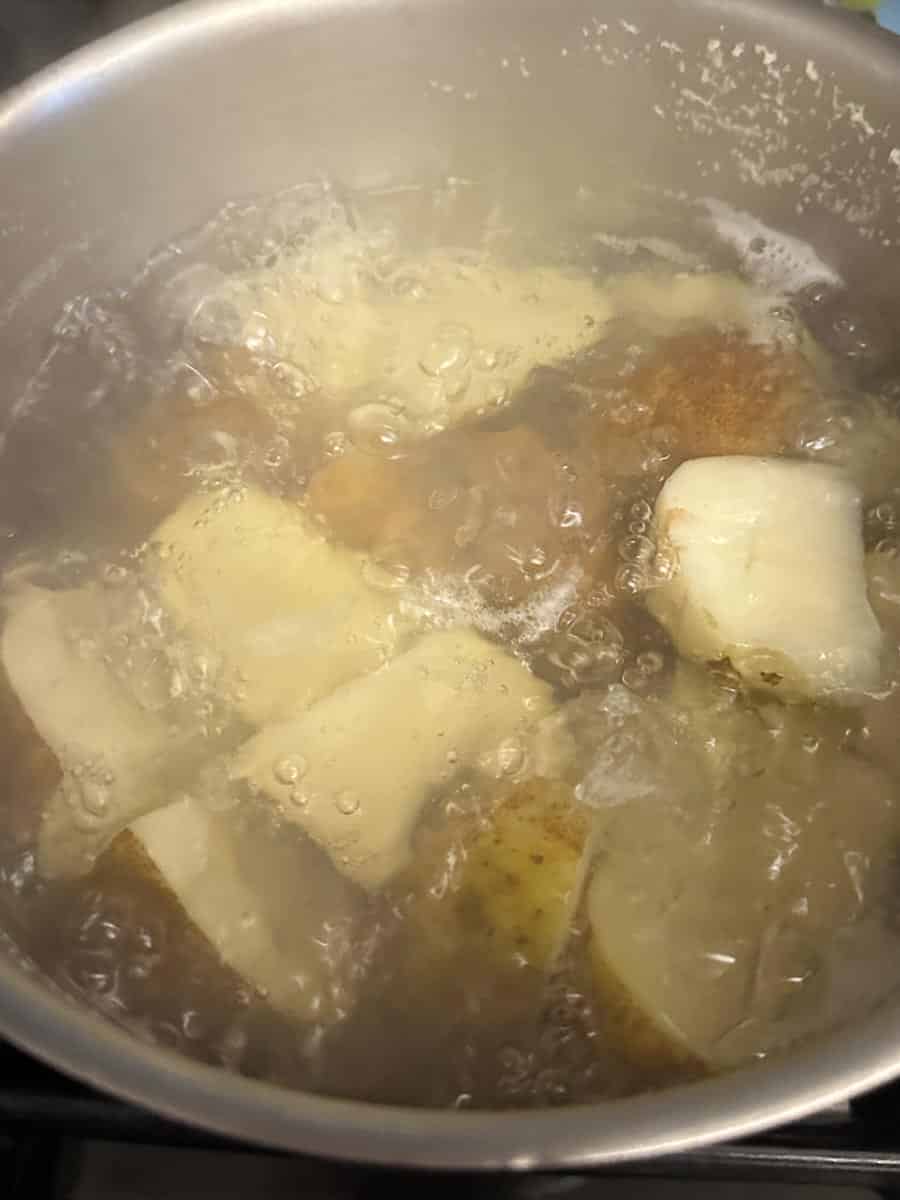
Cook until potatoes are tender when pierced with a knife, about 25 minutes. Drain in a colander and allow to cool while you cook the greens.
Place the same pot over low heat and add 4 tablespoons (57 g) of butter until it melts.
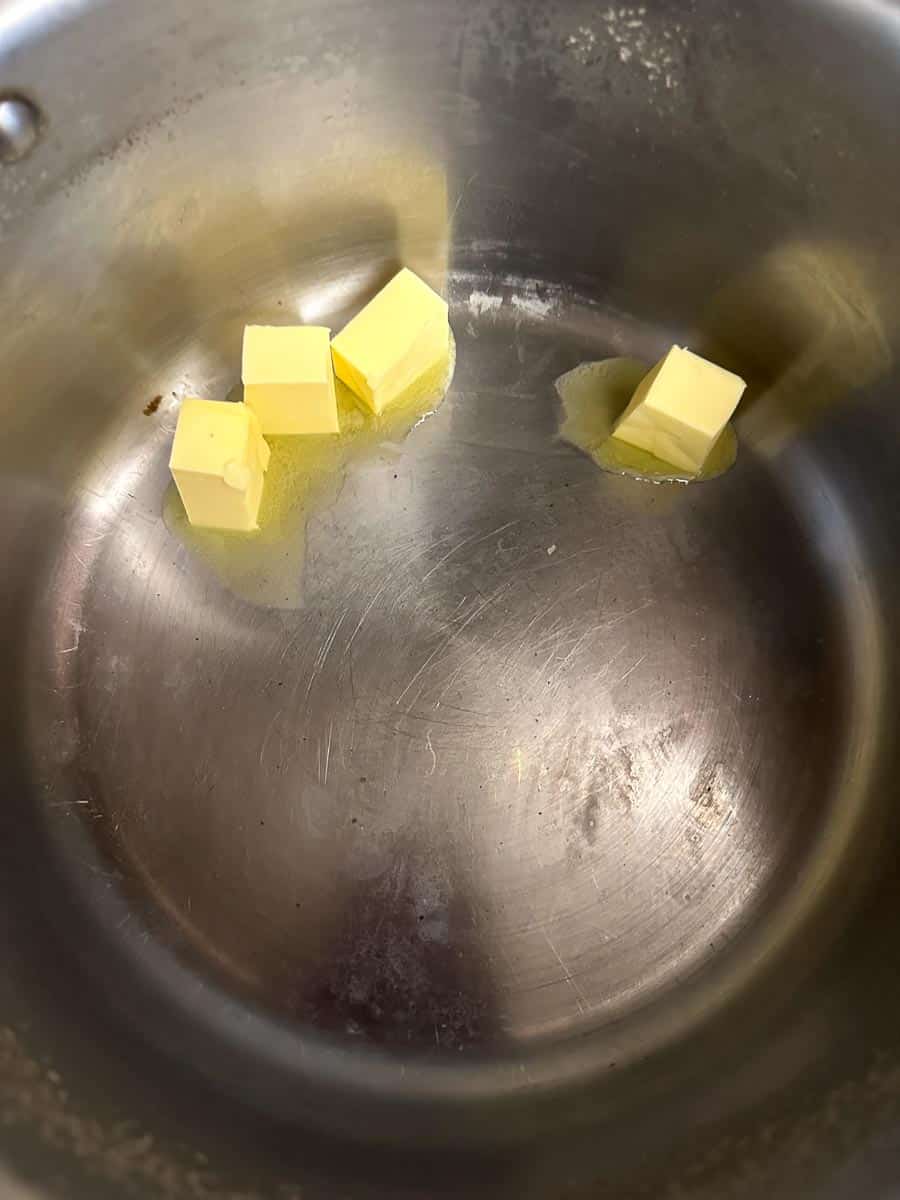
Add the cabbage, kale and scallion greens.
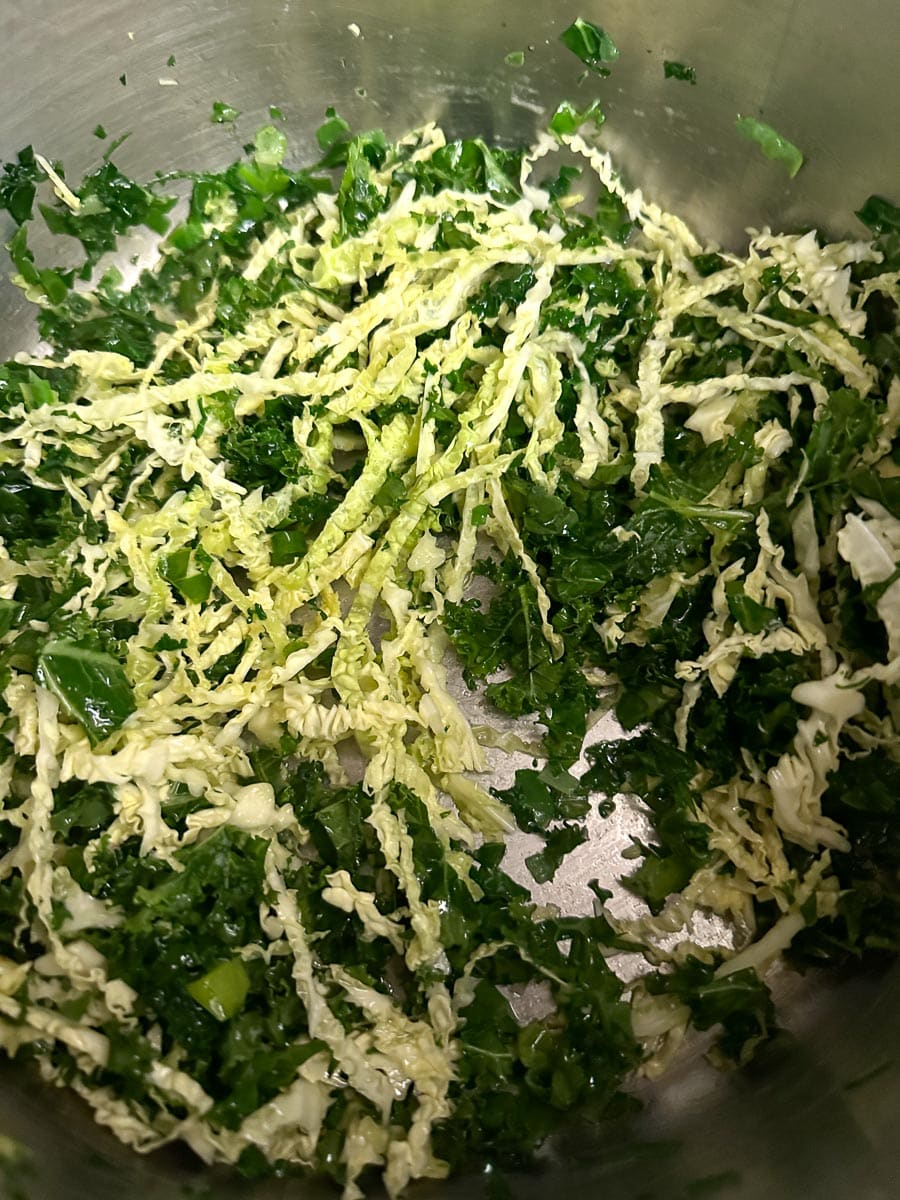
Sauté for about 5 minutes or until they are softened.
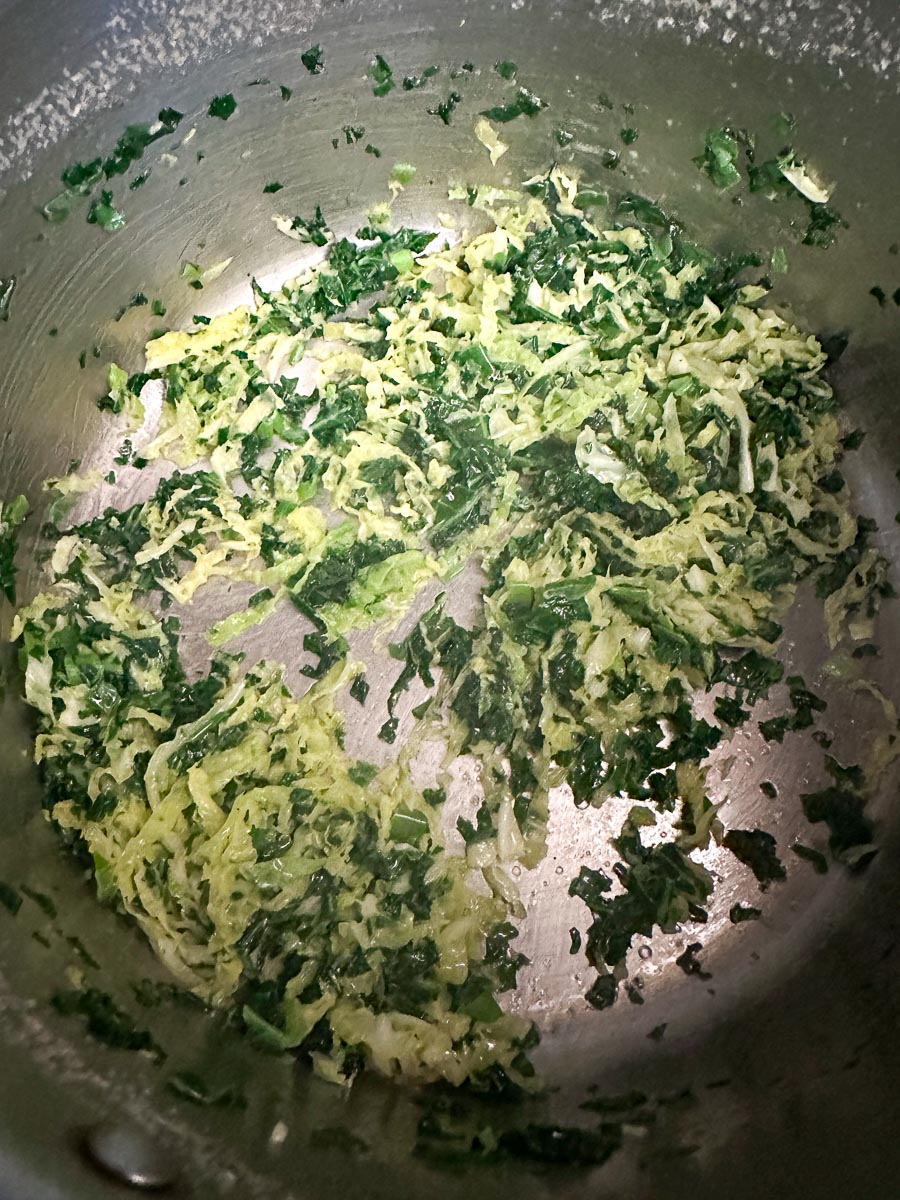
Add the milk and bring to a boil, then turn off the heat.
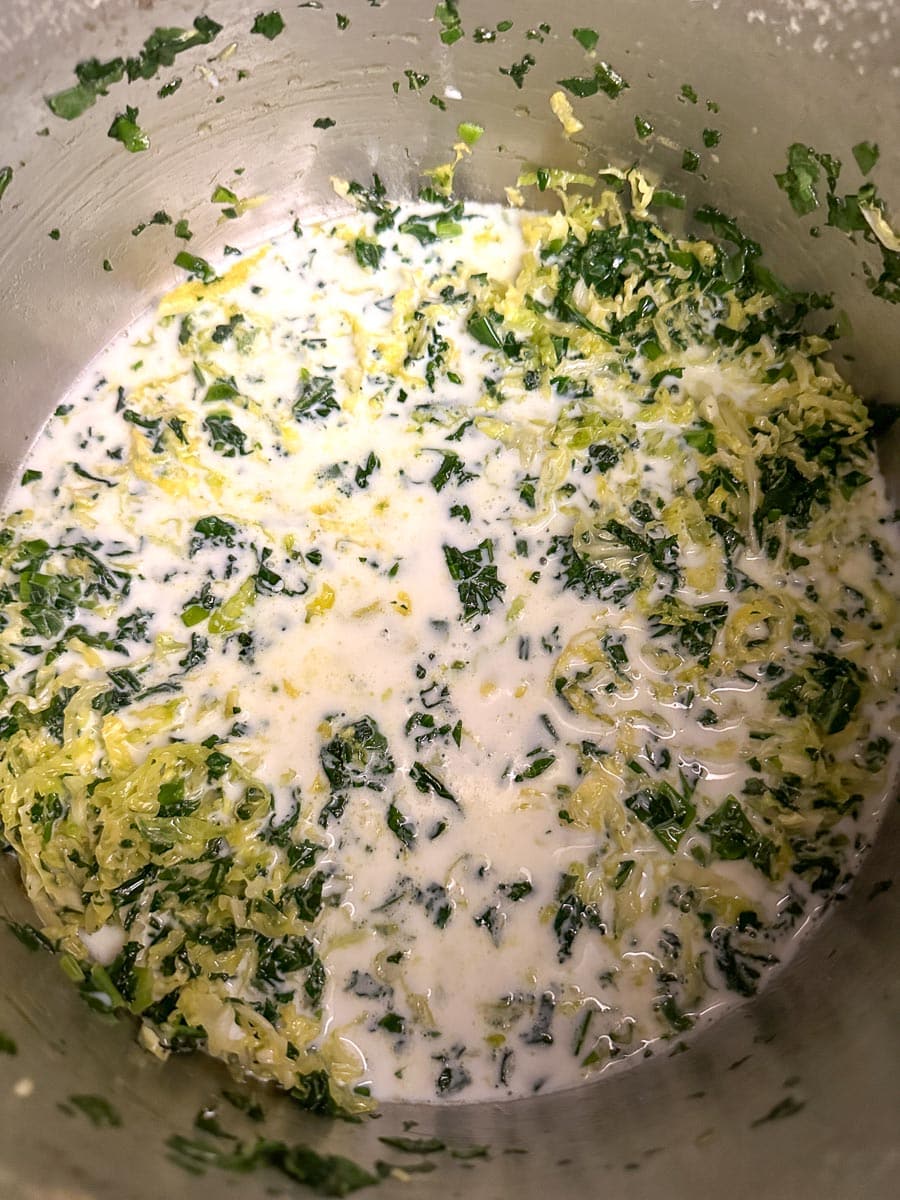
Meanwhile, slip the potatoes out of their skins and add them directly to the pot. Start mashing with a hand-held potato masher.
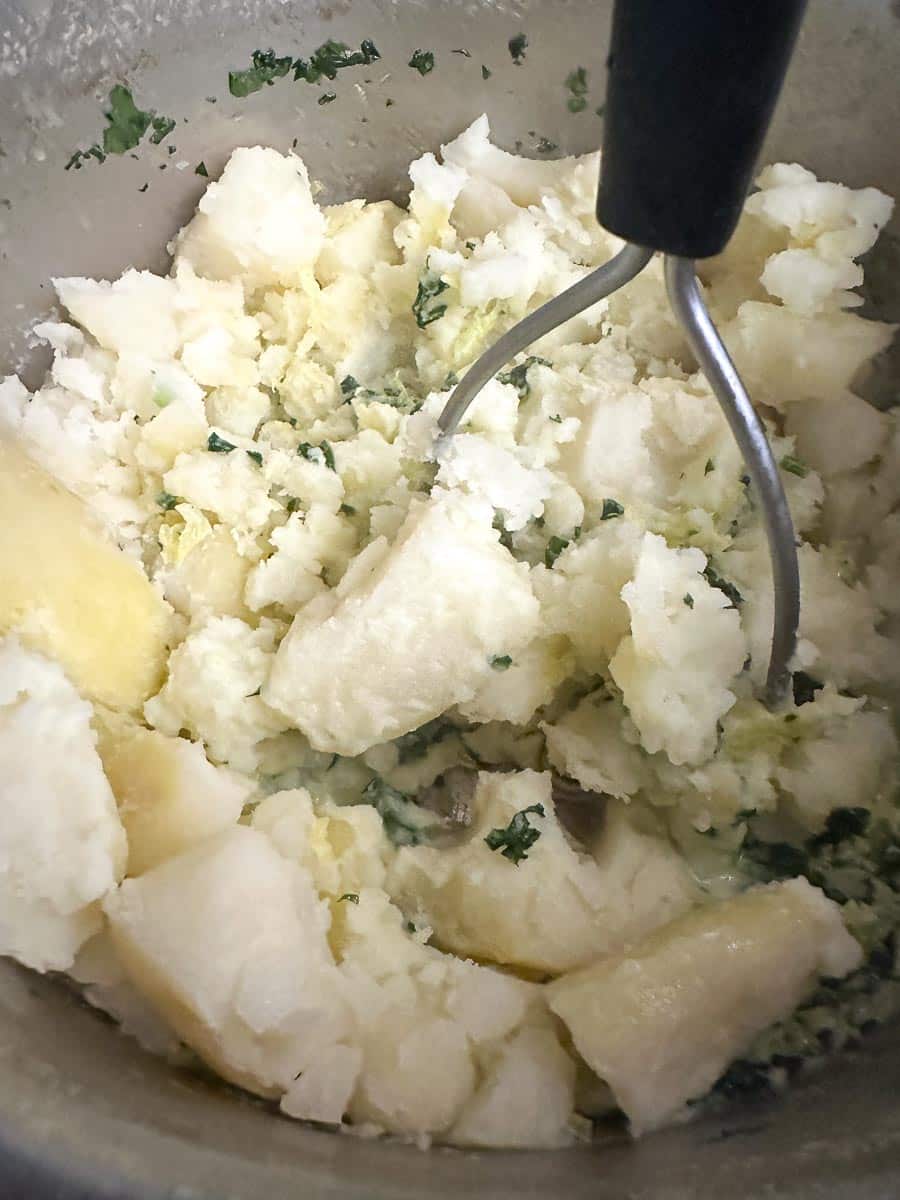
Taste and season with salt and pepper. You can do this over low heat if desired.
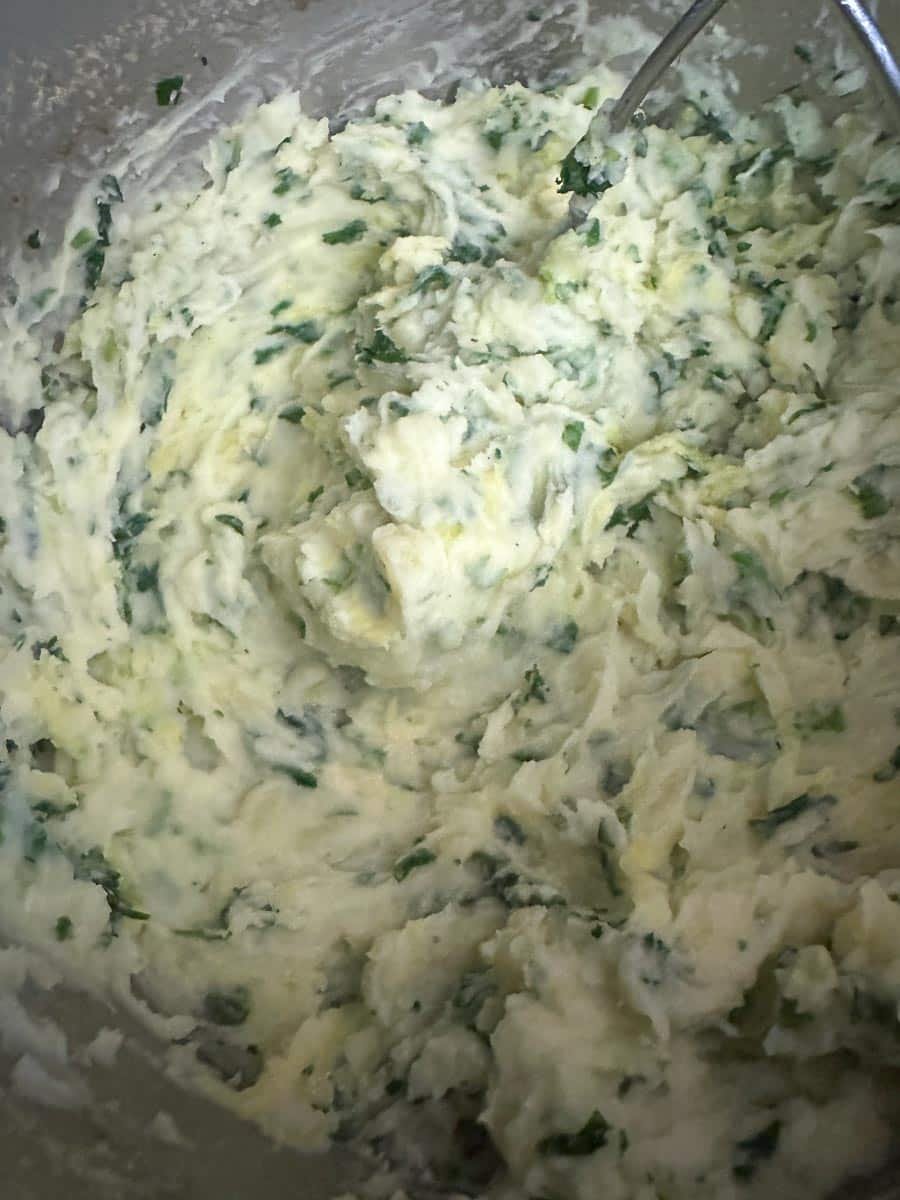
Serve immediately with an extra pat of butter on you mound of deliciousness.
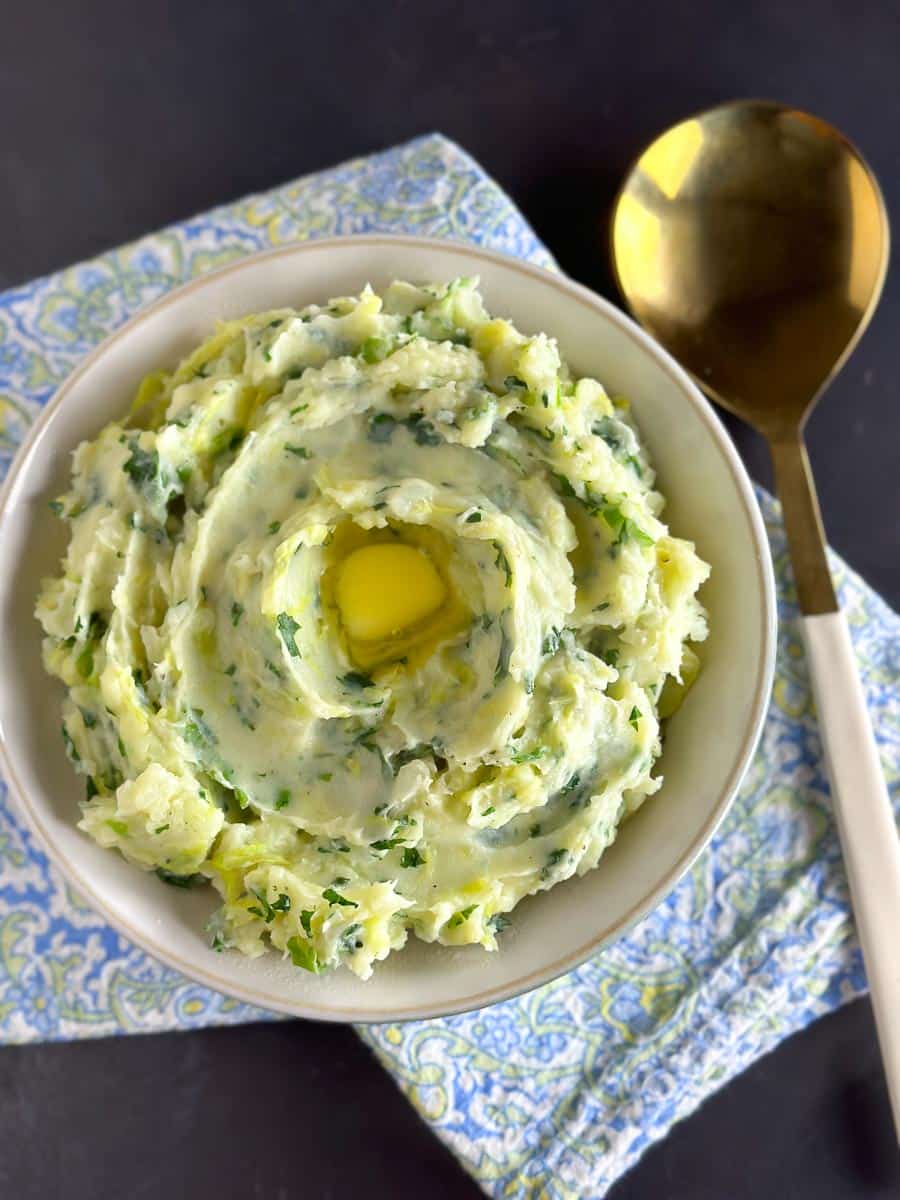
FODMAP Information
All recipes are based upon Monash University & FODMAP Friendly science at time of initial publication.
- Butter: Both Monash University and FODMAP Friendly have lab tested butter. Monash states that a low FODMAP Green Light portion is 1 tablespoon or 19 g and also states that “butter is high in fat and does not contain carbohydrates (FODMAPs)”. FODMAP Friendly gives it a “Pass” at 1 tablespoon or 19 g. Both recommended serving sizes are presented as part of healthy eating guidelines, not as maximum FODMAP serving size. Fat can affect guy motility and trigger IBS symptoms in some people. Eat to your tolerance.
- Cabbage: Both Monash University and FODMAP Friendly have lab tested various cabbages and reported their low FODMAP serving sizes. According to Monash Green Cabbage is low FODMAP in amounts of 75 g (¾ cup) and Red cabbage is low FODMAP in amounts of 75 g (¾ cup). According to Monash Savoy cabbage is low FODMAP in amounts of 40 g (½ cup). According to FODMAP Friendly Savoy cabbage is low FODMAP in amounts of 75 g (1 cup). According to both Monash and FODMAP Friendly, Napa cabbage is low FODMAP in amounts of 75 g (1 cup).
- Kale: Both Monash University and FODMAP Friendly have lab tested kale. Monash pictures Lacinato type kale and says that kale is Green light and low FODMAP in servings of ½ cup, chopped (75 g). FODMAP Friendly depicts curly kale and gives it a “Pass” at ½ cup chopped (30 g).
- Lactose-Free Dairy: Lactose-free dairy, such as lactose-free milk or lactose-free cream cheese, has lactase enzyme added that breaks the disaccharide molecules and creates a more digestible dairy product, from a lactose perspective. The resulting product is not dairy-free, but it is lactose-free. Some products might have miniscule amounts of lactose remaining, but the amount is small enough for the product to be labeled as lactose-free. For instance, Breyers Lactose-Free Vanilla Ice Cream states it is 99% lactose-free, while Lactaid Vanilla Ice Cream states it is 100% lactose-free.
- Scallions: Monash University lab testing found no FODMAPs detected in scallion greens; they suggest a 75 g serving size. FODMAP Friendly has also lab tested scallions: their recommended serving size for the green parts is 16 g, with a max low FODMAP serving of 161 g. They have also tested the bulb and it is low FODMAP in 19 g portions, which is about 2 tablespoons finely chopped.
Please always refer to the Monash University & FODMAP Friendly smartphone apps for the most up-to-date lab tested information. Foods will be retested from time to time; in the case of raw ingredients, such as fruits and vegetables, results may vary. All lab tested results are valid and represent a snapshot in time. As always, your tolerance is what counts; please eat accordingly. The ultimate goal of the low FODMAP diet is to eat as broadly as possible, without triggering symptoms, for the healthiest microbiome.
More Low FODMAP Irish Recipes
- Corned Beef & Cabbage
- Slow Cooked Corned Beef & Cabbage
- Irish Lamb Stew with Barley
- Irish Soda Bread
- Rich Irish Soda Bread
- Vegan Irish Soda Bread
- Irish Cream Liqueur
- Irish Coffee
- Irish Whiskey Chocolate Mousse
- Black Velvet Cake with Whiskey Frosting
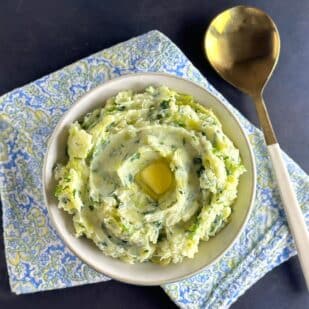
Low FODMAP Colcannon
Our Low FODMAP Colcannon features starchy mashed potatoes with shreds of tender cabbage and kale, lactose-free whole milk and rich Irish butter. Salt and pepper bring the flavors together in this classic Irish recipe. Colcannon is often served on St. Patrick’s Day, but it is a perfect potato side dish for any time of the year.
Ingredients:
- 2 ¾ to 3 pounds (1.3 to 1.4 kg) russet potatoes, very well-scrubbed, cut into large chunks
- 5 tablespoons (71 g) Irish butter, (high butterfat content butter), divided
- 2 cups (74 g) finely shredded green cabbage (core removed first)
- 2 cups (43 g) finely shredded curly kale (ribs removed first)
- ½ cup (32 g) finely chopped scallions, green parts only
- 1 cup (250 ml) lactose-free whole milk
- Kosher salt
- Freshly ground black pepper
Preparation:
-
Place potatoes in a large pot and cover with water by at least 1-inch (2.5 cm). Add a large pinch of kosher salt to the pot, cover and bring to a simmer. Cook until potatoes are tender when pierced with a knife, about 25 minutes. Drain in a colander and allow to cool while you cook the greens.
-
Place the same pot over low heat and add 4 tablespoons (57 g) of butter until it melts. Add the cabbage, kale and scallion greens and sauté for about 5 minutes or until they are softened. Add the milk and bring to a boil, then turn of the heat. Meanwhile, slip the potatoes out of their skins and add them directly to the pot. Start mashing with a hand-held potato masher. Taste and season with salt and pepper. You can do this over low heat if desired. Serve immediately with an extra pat of butter on you mound of deliciousness.
-
Colcannon can be reheated in the microwave or in the top of a double boiler, but we like it best freshly made.
Notes:
FODMAP Information
All recipes are based upon Monash University & FODMAP Friendly science at time of initial publication.
• Butter: Both Monash University and FODMAP Friendly have lab tested butter. Monash states that a low FODMAP Green Light portion is 1 tablespoon or 19 g and also states that “butter is high in fat and does not contain carbohydrates (FODMAPs)”. FODMAP Friendly gives it a “Pass” at 1 tablespoon or 19 g. Both recommended serving sizes are presented as part of healthy eating guidelines, not as maximum FODMAP serving size. Fat can affect guy motility and trigger IBS symptoms in some people. Eat to your tolerance.
• Cabbage: Both Monash University and FODMAP Friendly have lab tested various cabbages and reported their low FODMAP serving sizes. According to Monash Green Cabbage is low FODMAP in amounts of 75 g (¾ cup) and Red cabbage is low FODMAP in amounts of 75 g (¾ cup). According to Monash Savoy cabbage is low FODMAP in amounts of 40 g (½ cup). According to FODMAP Friendly Savoy cabbage is low FODMAP in amounts of 75 g (1 cup). According to both Monash and FODMAP Friendly, Napa cabbage is low FODMAP in amounts of 75 g (1 cup).
• Kale: Both Monash University and FODMAP Friendly have lab tested kale. Monash pictures Lacinato type kale and says that kale is Green light and low FODMAP in servings of ½ cup, chopped (75 g). FODMAP Friendly depicts curly kale and gives it a “Pass” at ½ cup chopped (30 g).
• Lactose-Free Dairy: Lactose-free dairy, such as lactose-free milk or lactose-free cream cheese, has lactase enzyme added that breaks the disaccharide molecules and creates a more digestible dairy product, from a lactose perspective. The resulting product is not dairy-free, but it is lactose-free. Some products might have miniscule amounts of lactose remaining, but the amount is small enough for the product to be labeled as lactose-free. For instance, Breyers Lactose-Free Vanilla Ice Cream states it is 99% lactose-free, while Lactaid Vanilla Ice Cream states it is 100% lactose-free.
• Scallions: Monash University lab testing found no FODMAPs detected in scallion greens; they suggest a 75 g serving size. FODMAP Friendly has also lab tested scallions: their recommended serving size for the green parts is 16 g, with a max low FODMAP serving of 161 g. They have also tested the bulb and it is low FODMAP in 19 g portions, which is about 2 tablespoons finely chopped.
Please always refer to the Monash University & FODMAP Friendly smartphone apps for the most up-to-date lab tested information. Foods will be retested from time to time; in the case of raw ingredients, such as fruits and vegetables, results may vary. All lab tested results are valid and represent a snapshot in time. As always, your tolerance is what counts; please eat accordingly. The ultimate goal of the low FODMAP diet is to eat as broadly as possible, without triggering symptoms, for the healthiest microbiome.
Nutrition
All nutritional information is based on third-party calculations and should be considered estimates. Actual nutritional content will vary with brands used, measuring methods, portion sizes and more. For a more detailed explanation, please read our article Understanding The Nutrition Panel Within Our Recipes.
